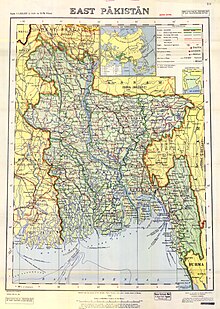
Since the Partition of British India in 1947 and subsequent creation of the dominions of India and Pakistan, the two countries have been involved in a number of wars, conflicts, and military standoffs. A long-running dispute over Kashmir and cross-border terrorism have been the predominant cause of conflict between the two states, with the exception of the Indo-Pakistani War of 1971, which occurred as a direct result of hostilities stemming from the Bangladesh Liberation War in erstwhile East Pakistan.
Hamidur Rahman was a sepoy in Bangladesh Army during the Bangladesh Liberation War. Rahman was killed on 28 October 1971 at Dholoi during the Battle of Dhalai, Srimangal during an attempt to capture the Pakistani Army position. The advancing Mukti Bahini column finally captured the Dhalai Border Outpost on 3 November 1971. He was posthumously awarded the Bir Sreshtho, the highest recognition of bravery in Bangladesh. The Dhalai post was eventually captured permanently by three infantry battalions belonging to 61 Mountain Brigade, one battalion belonging to East Bengal Regiment and 7 Rajputana Rifles supported by an artillery brigade of the Indian Army fought against 12 Frontier Force Regiment of the Pakistan Army.
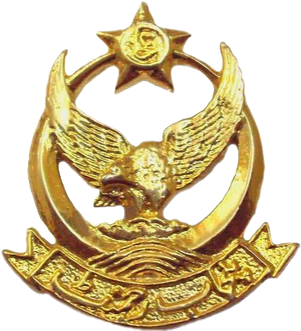
The Punjab Regiment is an infantry regiment of the Pakistan Army. The regiment takes its name from the historic Punjab region, which is now divided into the Punjab province of Pakistan and the Indian states of Punjab, Haryana and Himachal Pradesh. It was raised in its current form in 1956, following the amalgamation of the 1st, 14th, 15th and 16th Punjab regiments that were inherited by the Dominion of Pakistan from the British Indian Army upon the Partition of India. Since then, the regiment has expanded in size to 63 battalions.

Lakshmipur is a district in Bangladesh with an area of 1,440 km2. It is bordered by Chandpur to the north, Bhola and Noakhali districts to the south, Noakhali to the east, and Barisal and Bhola districts to the west. Lakshmipur was part of Noakhali until 15 February 1984. At that time, the western part of Noakhali was promoted from Lakshmipur subdivision to Lakshmipur district to provide administrative facilities.
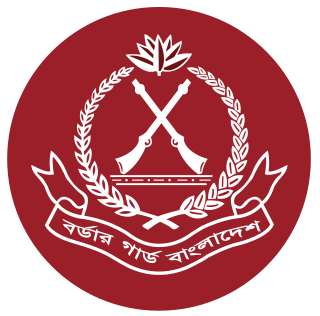
The Border Guard Bangladesh (BGB) is a paramilitary force responsible for the border security of Bangladesh. The BGB is entrusted with the responsibility to defend the 4,427 kilometres (2,751 mi) border of Bangladesh with India and Myanmar. It was formerly known as the Bangladesh Rifles (BDR).
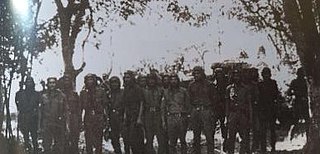
The Battle of Garibpur was fought between the Indian forces and Pakistani forces for the control of the village of Garibpur, now in Bangladesh. On 20 November 1971, Indian troops of the 14th Battalion of the Punjab Regiment with 14 supporting PT-76 tanks from the 45 Cavalry moved in to capture the areas around Garibpur in Pakistani territory. The battle started by Pakistani troops counterattacking the next day to recapture Garibpur.

Major Tufail MohammadNH, NH, was a Pakistani military officer and the second military officer in the Pakistani military who was cited as the third recipient of Pakistan's highest military award, the Nishan-e-Haider for his actions of valor during the 1958 East Pakistan-India border clashes.
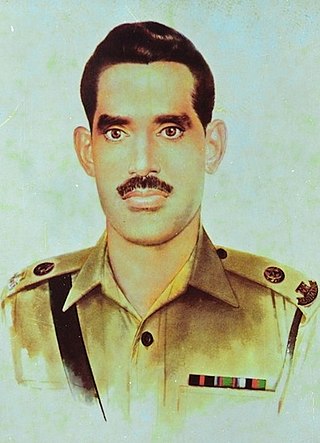
Major Muhammad AkramNH was a Pakistani military officer who was cited as the sixth recipient of Pakistan's highest military award, the Nishan-e-Haider, which he was awarded posthumously for his actions of valour in the Battle of Hilli during the Bangladesh Liberation War.

This is a timeline of Pakistani history, comprising important legal and territorial changes and political events in the region of modern-day Pakistan. To read about the background of these events, see History of Pakistan and History of the Islamic Republic of Pakistan.

Naik Muhammad Mahfuz Janjua was a Pakistani soldier, who was awarded the Nishan-e-Haider, the highest military award of Pakistan, after he was killed in action during the Indo-Pakistani War of 1971.

The 2001 Bangladesh–India border clashes were a series of armed skirmishes between India and Bangladesh in April 2001. The clashes took place between troops of the Bangladesh Rifles (BDR) and the Indian Border Security Force (BSF) on the poorly-marked international border between the two countries.

Ramgati is an upazila (sub-district) of Lakshmipur District in Bangladesh, part of the Chittagong Division. The Government of Bangladesh plans to build an airport in this upazila.

A series of occasional armed skirmishes and firefights have occurred along the Afghanistan–Pakistan border between the Afghan Armed Forces and the Pakistan Armed Forces since 1949. The latest round of hostilities between the two countries began in April 2007. Militants belonging to Tehrik-i-Taliban Pakistan and Jamaat-ul-Ahrar also use Afghanistan's territory to target Pakistani security personnel deployed along the border. The Diplomat says that the presence of terrorists belonging to Tehrik-i-Taliban Pakistan on Afghan soil is the reason for sporadic shelling of Afghanistan's territory by Pakistani security forces.

Bangladesh's military history is intertwined with the history of a larger region, including present-day India, Pakistan, Nepal, Bhutan and Myanmar. The country was historically part of Bengal – a major power in South Asia and Southeast Asia.
The border skirmishes between the United States and Pakistan were the military engagements and confrontations between Pakistan and the United States that took place along the Afghanistan-Pakistan border from late 2008 to late 2012 resulting in the deaths of 55 Pakistani personnel with a unknown number of U.S. casualties. These incidents involved the U.S. Forces-Afghanistan Command and ISAF forces, who had been present in Afghanistan fighting Taliban and al-Qaeda insurgency, and the unified Western military command of the Pakistan Armed Forces against one another in a series of skirmishes that ceased shortly after the 2011 NATO attack in Pakistan. The two sides ultimately made peace and continued collaboration operations against insurgent groups in Pakistan following an official, however brief, apology from then-U.S. Secretary of State Hillary Clinton on 3 July 2012 over the loss of life suffered by the Pakistani military.
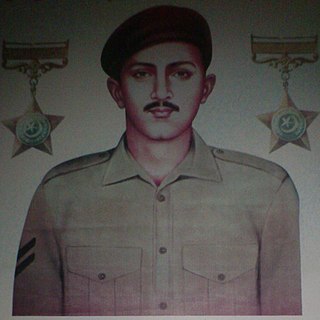
Naik Saif Ali Janjua was a Pakistani non-commissioned officer of the Azad Kashmir Regiment who previously served overseas for four years in the British Indian Army during World War II. He joined the Pakistan Army after the Partition of British India and was a Platoon Commander during the Indo-Pakistani War of 1947-1948. He is known for establishing the Haidri Force on 1 January 1948, with the support of Sardar Fateh Muhammad Karailvi.
The Defence of Kamalpur was a second battle fought over Kamalpur near the border between India and East Pakistan during the Bangladesh Liberation War. Kamalpur, a hamlet on the border, was defended by 60-70 regular and paramilitary Pakistani soldiers under the command of Captain Ahsan Malik.

The 2013 India–Pakistan border incidents was a series of armed skirmishes along the Line of Control (LoC) in the disputed Kashmir area. Starting from the mid-January 2013, they have been described as the "worst bout of fighting in the region in nearly 10 years". It began on 6 January 2013, when according to Pakistani reports Indian forces attacked a Pakistani border post, killing one soldier. Indian authorities claimed the incident as a retaliation against preceding Pakistani ceasefire violations, but denied having crossed the demarcation line. In a second skirmish on 8 January, Indian authorities said that Pakistani forces crossed the LoC, killing two Indian soldiers. The incident sparked outrage in India and harsh reactions by the Indian army and government over the news that the body of one of the soldiers had been beheaded. Pakistan denied these reports. On 15 January, a third skirmish reportedly led to the death of another Pakistani soldier.
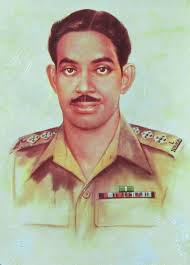
Captain Raja Muhammad Sarwar BhattiNH, BS, best known as Muhammad Sarwar, was a Pakistani military officer who was cited as the first recipient of Pakistan's highest military award, Nishan-e-Haider, for his gallantry and actions of valor during the First Indo-Pakistani War of 1947–48.

The 2020–2021 India–Pakistan border skirmishes were a series of armed clashes between India and Pakistan along the Line of Control in the disputed region of Kashmir, which is subject to extensive territorial claims by both countries. The standoff intensified when a major exchange of gunfire and shelling erupted between Indian and Pakistani troops in November 2020 along the Line of Control which left at least 22 dead, including 11 civilians.
